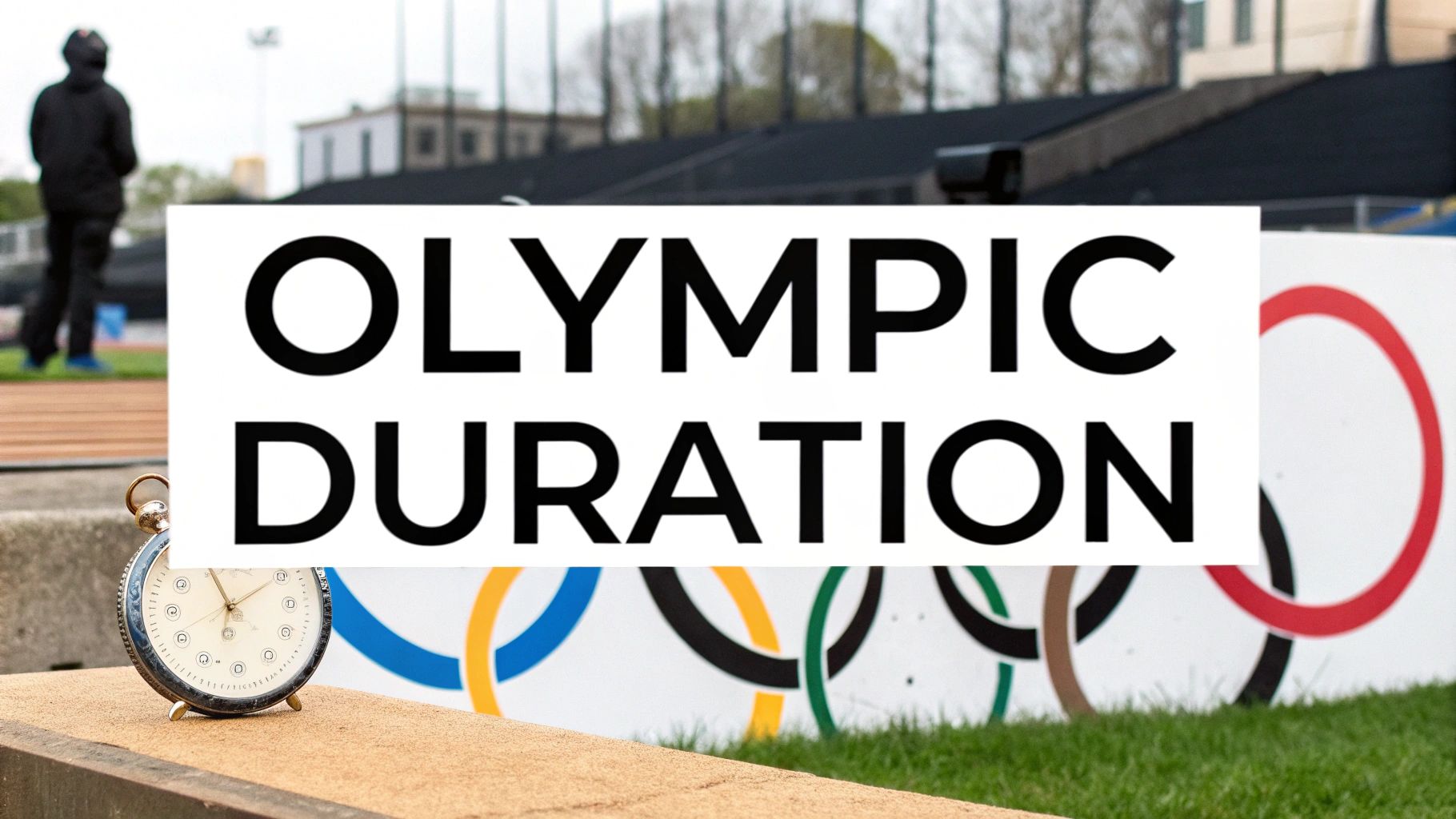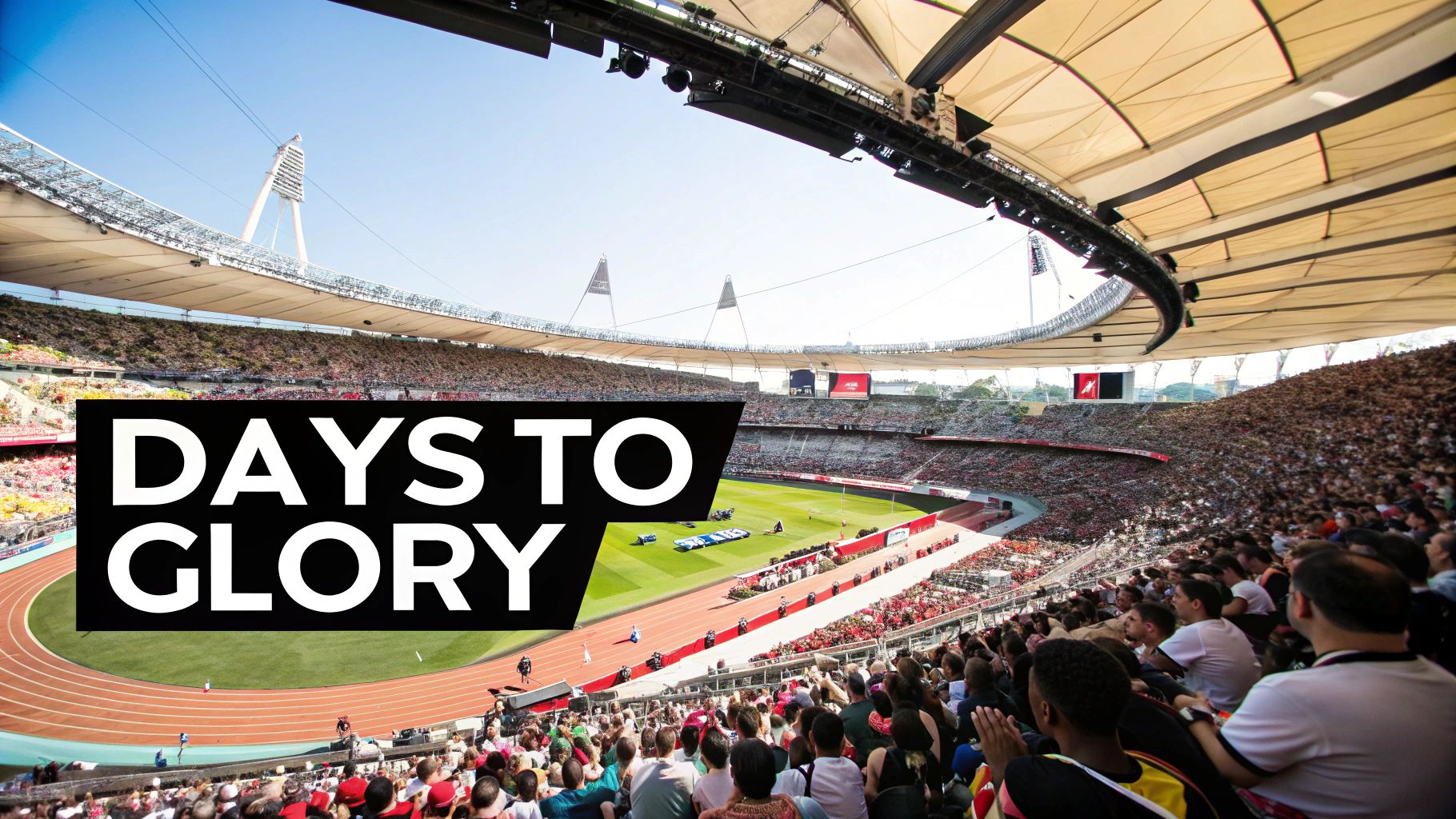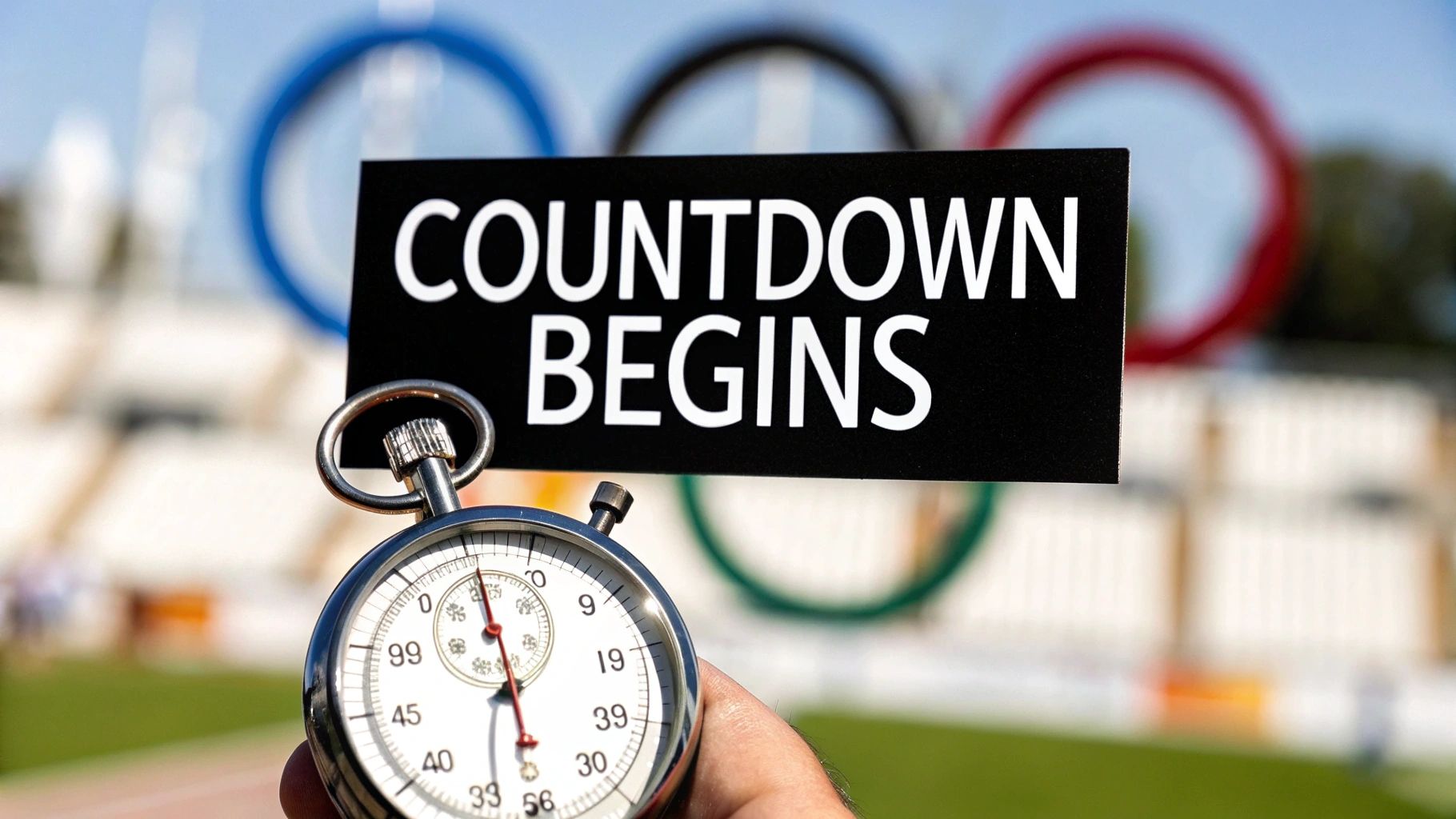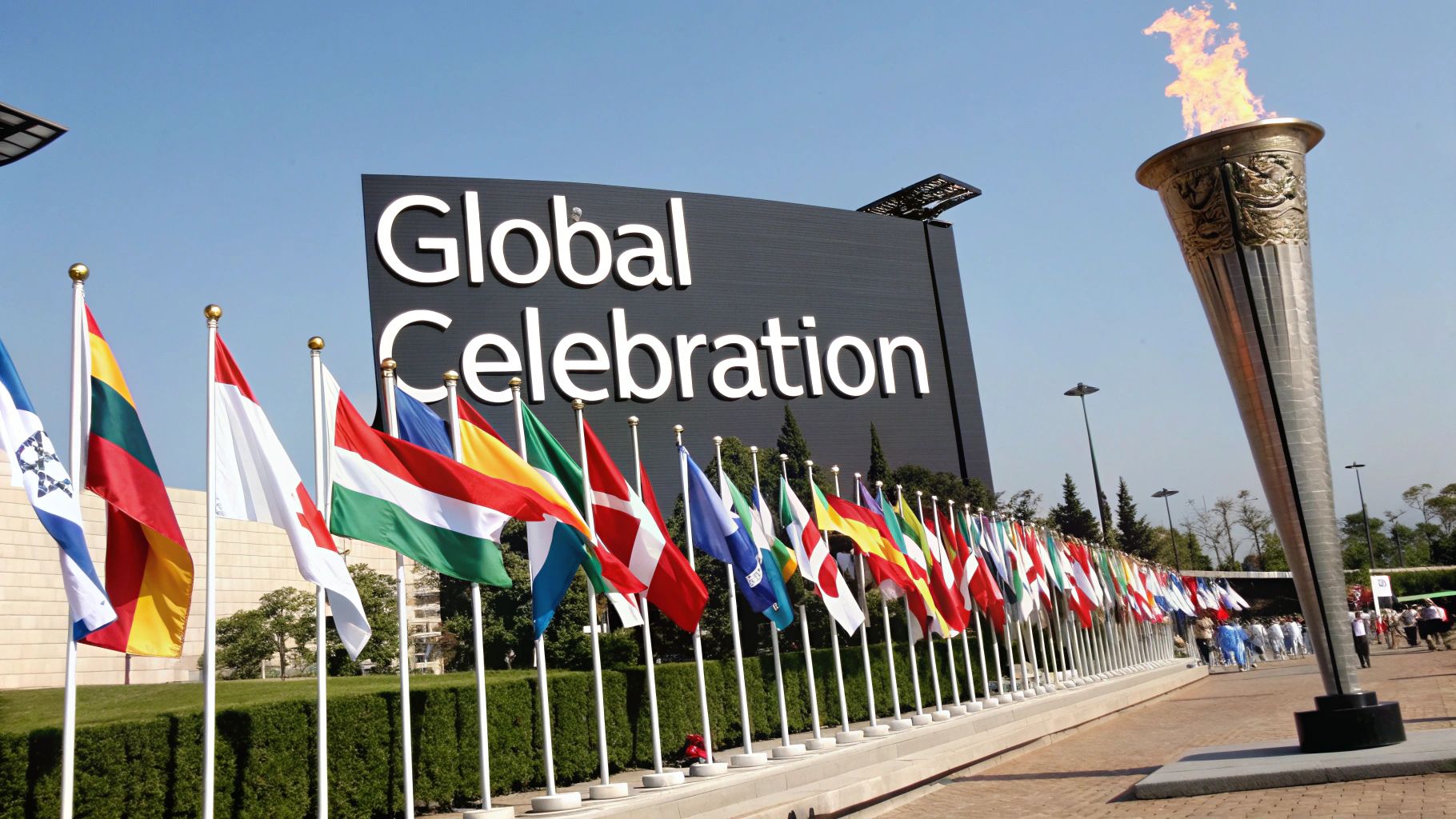Olympics: How Many Days Do The Games Really Last? Your Complete Guide

The Evolution of Olympic Timelines: Ancient Marathon to Modern Sprint

The Olimpic Games we know today take place over just 16-18 days, but this wasnt always the case. In anciant Greece, the Olympics were a sprawing religous and cultural festval that lasted 5-6 months. This extended timline aligned perfectly with agricultural cyces, giving people ample oportunity to travel, compete, and celabrate. The dramatic shift from a months-long celabration to today's compressed scheduel reflects broader changes in societty, tecnology, and the global nature of the modern Games.
From Sacred Rituals to Global Spectacle: A Shift in Focus
Religion was at the heart of the ancient Olympics, with competitions dedicated to Zeus. The events weren't just about athletic achievement - they were part of a larger celebration featuring religious ceremonies, artistic performances, and community gatherings. For instance, participants would spend days performing sacrificial rituals and ceremonies - practices that no longer exist in the modern Games. As the religious aspects faded away over time, the focus narrowed to pure athletic competition, making a shorter timeline more practical.
The Modern Olympics: Time is of the Essence
When the Olympics were revived in 1896, organizers had to adapt the Games for a very different world. The pace of life had accelerated, and people could no longer spend months at a festival. More importantly, athletes were coming from across the globe, not just Greece and its neighbors. This new reality demanded a more compact schedule that could accommodate international travel while maintaining the spirit of competition.
Broadcasting and the Rise of the 16-Day Format
Television changed everything about how we experience the Olympics. As the Games became must-see TV, broadcasters needed a consistent, manageable schedule for programming. This need, combined with an ever-growing list of sports and athletes, led organizers to settle on the current 16-day format. This timeframe strikes a sweet spot - long enough to showcase all events but short enough to keep viewers engaged. After all, maintaining global interest in a months-long event would be nearly impossible in our fast-paced media environment.
Balancing Tradition and Modernity
While today's Olympics may look very different from the ancient Games, many traditional elements remain. The opening and closing ceremonies, the Olympic flame, and medal presentations all connect us to that ancient heritage. These rituals have been thoughtfully adapted to fit within the modern timeline, creating a bridge between past and present. The shorter, more focused format of today's Olympics has made the Games more accessible than ever, allowing billions of people worldwide to share in this celebration of athletic achievement.
Breaking Down the Modern Olympic Calendar: 16 Days of Glory
The modern Olympic Games have evolved into a precisely orchestrated 16-day event that brings together athletes and spectators from around the world. This compact timeframe is quite different from the ancient Greek Olympics, which could stretch on for months. Today's Olympics require careful planning to accommodate hundreds of events across dozens of sports while managing thousands of athletes and support staff. The 16-day schedule reflects years of refinement in balancing athlete needs, broadcast requirements, and complex event logistics.
Balancing Act: Athlete Performance and Global Viewership
When planning the Olympic schedule, athlete performance is a top priority. Sports federations work with organizers to build a timeline that gives competitors proper recovery between events. This is especially important for athletes participating in multiple competitions. For instance, swimmers often compete in several races over multiple days, requiring careful spacing to maintain peak performance. The schedule must also consider the physical demands unique to each sport while creating an engaging flow of events for spectators.
The global nature of the Olympics adds another layer of scheduling complexity. Broadcast networks invest heavily in coverage rights and need events scheduled during prime viewing hours in major markets. This often leads to creative scheduling - like holding swimming finals in the morning local time so they air during evening hours in key broadcast regions. These scheduling decisions help maintain the Olympics' status as a truly international event that connects with audiences worldwide.
Venue Logistics and the Flow of Competition
Managing multiple competition venues presents a significant planning challenge. The 2016 Rio Olympics showcased this complexity with 306 events across 42 sports. Organizers must coordinate everything from venue preparation and equipment setup to staff scheduling and athlete transportation. The schedule needs to account for practical considerations like travel time between facilities while ensuring smooth transitions between events throughout each day.
The competition schedule follows a natural progression that builds excitement over the 16 days. Early rounds typically fill the first week as the field narrows through preliminary competitions. Medal events increase during the second week, creating mounting tension as champions are crowned. This thoughtful pacing helps viewers follow their favorite sports while maintaining interest through the closing ceremony. The schedule creates natural storylines that unfold over the duration of the Games.
Learning from the Past: Adapting and Refining the Schedule
While the 16-day format has become standard, it continues to evolve based on feedback and changing needs. Each Olympic Games provides lessons that shape future planning. The addition of new sports like sport climbing and skateboarding requires creative integration into the existing schedule framework. Organizers analyze viewership data, athlete feedback, and operational metrics to refine and improve the Olympic calendar. This commitment to evaluation and adaptation helps the Games remain engaging for new generations while honoring their rich history. The modern 16-day Olympic schedule represents decades of learning how to present this celebrated sporting event in its most compelling form.
Behind the Curtain: The Pre-Games Timeline That Nobody Sees

While spectators worldwide tune in for the Olympics' 16-18 day competition schedule, an enormous effort unfolds behind the scenes months before the first athlete arrives. This preparation period, which extends far beyond the actual games, involves thousands of workers transforming the host city into a world-class sporting venue. When people ask "olympics how many days," they often don't realize the extensive groundwork required to make the games possible.
Constructing a Global Village: More Than Just Bricks and Mortar
The Olympic Village represents one of the most complex aspects of pre-games preparation. Weeks before athletes arrive, teams work tirelessly to convert empty buildings into a fully-functioning community. This includes furnishing thousands of rooms, establishing dining facilities that can serve over 60,000 meals daily, and setting up essential services like medical centers and recreation areas. The goal is to create an environment where athletes can focus entirely on their training and competition, knowing all their basic needs are met.
Coordinating the Chaos: Training Schedules and Venue Readiness
Managing training schedules across multiple venues requires precise planning and timing. Each sport has specific requirements - from maintaining exact temperatures in swimming pools to ensuring perfect surface conditions in gymnastics arenas. Venue managers must work closely with sports federations to create training schedules that give all athletes fair access to facilities. This careful coordination ensures every competitor has proper preparation time while maintaining the venues in peak condition for the actual events.
The Arrival of Nations: Logistics and Security
The task of welcoming thousands of athletes, coaches, officials, and media personnel from across the globe requires extensive planning. This involves coordinating with airlines, processing visas, managing accreditation, and implementing comprehensive security measures. The host city effectively becomes a miniature United Nations, complete with dedicated transportation systems and security checkpoints. Staff and volunteers undergo cultural awareness training to create a welcoming atmosphere for all participants. This detailed preparation in the weeks leading up to the games ensures that when the competition begins, everything runs according to plan.
Mastering Olympic Time Management: The Science of Scheduling
Planning the Olympics requires carefully orchestrating thousands of moving parts across 16-18 action-packed days. The schedule must account for athlete needs, global broadcasting, venue logistics, and weather variables to ensure everything runs smoothly.
The Athlete-Centric Approach: Balancing Performance and Recovery
Athletes are the heart of the Olympics, and their wellbeing drives the scheduling process. Event organizers work with sports federations to create a program that allows adequate rest and recovery between competitions. For example, track athletes competing in multiple events need proper spacing to perform at their peak without risking injury. By putting athletes first, the schedule enables fair competition where everyone can showcase their best.
A Global Stage: Navigating Time Zones and Broadcast Demands
With billions of viewers worldwide tuning in to watch the Olympics, scheduling must balance the needs of multiple time zones. Major events are strategically timed to reach the largest possible audience across key regions. This means some competitions happen at non-traditional local times - like holding swimming finals in the morning to catch prime-time viewers in North America and Europe. Through thoughtful scheduling, organizers make the Games accessible to fans everywhere.
Venue Orchestration: A Logistical Symphony
Managing dozens of sports across multiple venues requires precise coordination. Organizers must smoothly transition between events while avoiding scheduling conflicts. This involves detailed planning around venue availability, equipment setup, and athlete transport. The 2016 Rio Olympics illustrates this complexity - organizers had to coordinate 306 events across 42 sports. Success depends on seamless venue management.
Weather Contingency and Adaptability: Expecting the Unexpected
Outdoor competitions are always subject to weather disruptions, so organizers build flexibility into the schedule. Whether it's rain during beach volleyball or strong winds affecting sailing, backup plans help minimize delays while ensuring safety. At the Tokyo 2020 Olympics (held in 2021), extreme heat forced some events to move to cooler times. Having contingency plans is essential for handling unexpected changes.
Technology's Role: Optimizing Efficiency and Transparency
Modern scheduling tools help manage the intricate web of Olympic events and information. Software enables real-time updates so everyone stays informed about schedule changes. Athletes, media, and spectators can easily access event timing details through digital platforms. This technology-enabled transparency and efficiency helps deliver a seamless Olympic experience from start to finish.
The Paralympic Games: Extending the Olympic Spirit

As the Olympic Games conclude, the Paralympic Games begin their own remarkable showcase of athletic excellence. This transition represents an incredible feat of organization and planning. When considering the Olympic timeline, we must look at both events as part of one grand celebration of sport that spans several weeks.
Transforming Venues and Maintaining Momentum
Once the Olympic flame is extinguished, venue teams spring into action to prepare facilities for Paralympic athletes. Each space requires specific adaptations - basketball courts need modifications for wheelchair competition, swimming pools must have proper access points, and seating areas need wheelchair accessibility. These rapid changes happen behind the scenes while maintaining the electric atmosphere that made the Olympics special.
Unique Scheduling Considerations for Paralympic Sports
Creating the Paralympic competition schedule requires careful attention to detail. With multiple sport classifications and specialized rules, organizers must balance fair competition with athlete recovery time. The schedule also aims to give each sport proper media coverage so audiences can fully appreciate the skill and determination of Paralympic athletes.
Operational Excellence Across Two Major Events
Running two major international sporting events back-to-back demands precision and dedication. Host cities must maintain high standards for transportation, security, venue operations and volunteer support throughout both Games. This means adapting services to meet different needs while ensuring consistent quality. Close coordination between Olympic and Paralympic organizing teams helps deliver an outstanding experience for all participants.
Transitioning Between Games and Maintaining Volunteer Engagement
The changeover period buzzes with activity as venues transform and operations shift gears. Thousands of volunteers, who form the backbone of both events, recommit their time and energy. Their enthusiasm and dedication help bridge the transition and maintain momentum. Many volunteers serve at both Games, gaining unique perspectives on how the events complement each other.
The Paralympics: A Celebration of Resilience and Achievement
The Paralympic Games showcase extraordinary athletic talent while promoting inclusion in sport. Athletes competing here inspire millions by demonstrating what's possible through determination and skill. From carefully adapted venues to dedicated volunteers, every aspect of the Paralympics celebrates human potential. While the Olympics may draw initial attention, the Paralympic Games prove equally compelling through athletic excellence and personal triumph. Together, these events expand our understanding of sport's power to unite and inspire.
You may try to change image description.
Impact and Legacy: What Olympic Duration Means for Everyone

The Olympic Games' 16-day schedule creates waves of impact that reach far beyond the stadium walls. This two-week period shapes the experiences of athletes, host cities, and global audiences in profound ways. By examining how this timeframe affects each group, we can better understand what makes the Olympics such a unique sporting event and why its duration plays such a vital role in its success.
The Athlete's Perspective: Peak Performance and Recovery
For Olympic athletes, these 16 days represent the culmination of years of dedication and training. The schedule demands precise timing - athletes must reach their physical peak at exactly the right moment while managing their energy across multiple events. Take swimmers, for instance. Many compete in several races over just a few days, making proper rest between events essential for success. This intense schedule tests not only physical limits but mental resilience as well, as athletes balance the pressure to perform with the need to maintain focus throughout the competition.
The Host City's Dilemma: Economic Boom and Infrastructure Strain
When cities welcome the Olympics, they experience both opportunities and challenges. The 2016 Rio Olympics showed how complex hosting can be - organizing 306 events across 42 sports required careful planning and substantial resources. Cities must expand their transportation systems, build new venues, and ensure adequate housing for thousands of athletes and visitors. While this investment can spark positive changes like improved infrastructure and increased tourism, cities must plan carefully to avoid the financial strain that has troubled past hosts. Success depends on finding ways to use Olympic facilities and improvements long after the closing ceremony.
The Global Audience's Engagement: Captivating Storylines and Media Coverage
The Olympic schedule creates a sweet spot for viewer engagement - long enough to build compelling stories but short enough to maintain excitement throughout. People worldwide tune in to follow their favorite athletes and discover new sports, sharing in moments of triumph and disappointment. When someone asks "Olympics how many days does it last?" they're really asking about this special period when the world comes together to celebrate athletic achievement. The challenge lies in keeping viewers interested amid constant media coverage while allowing enough time for meaningful competition stories to develop.
The Future of Olympic Time: Adapting to a Changing World
As sports and media continue to evolve, the Olympic format may need to adapt while preserving its essential character. The current 16-day schedule works well, but organizers must consider how changing viewer habits and new broadcasting technologies might affect future Games. Finding the right balance between tradition and innovation will be key to keeping the Olympics relevant and exciting for new generations of athletes and fans.
Are you ready to experience the magic of Paris? Discover the charm, history, and elegance of this iconic city during the upcoming Olympics! Book your stay at one of Paris's charming boutique hotels and immerse yourself in the unforgettable atmosphere. Explore everything Paris has to offer, from iconic landmarks and world-class museums to exquisite dining and exclusive shopping: https://www.boutique-hotels.paris/